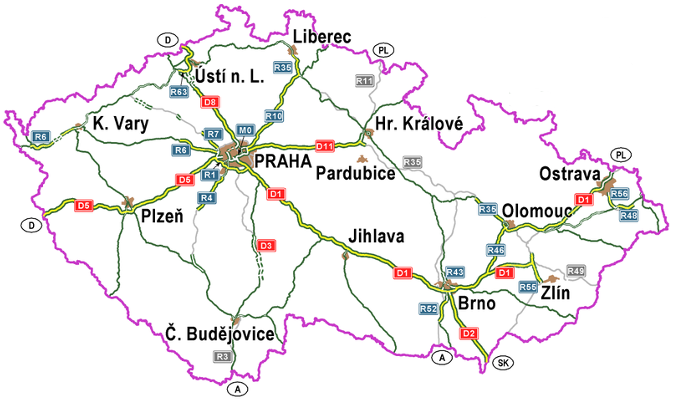With the Czech Republic representing the crossroads of Central Europe, roads have historically been plentiful. However, with the onset of the 1980s and 1990s, the need for an increasing number of roads became apparent. Currently, there are some 128 thousand kilometers of roads in the country, with many more planned for the future. Further construction is ongoing and planned with over 4.5 million cars on the roads today. Naturally, there are various classifications of roads depending on their designation. Let’s have a look at what these are within the Czech Republic.
Road Classification
Highways – roads that have multiple lanes in both directions, and are intended for fast long distance travel between large cities and/or international travel. In the majority, tolls and fees (see below) apply. The speed limit is set at 130km/h.
Roads
• 1st class roads (expressways) – much like highways, intended for fast intercity and international travel ( 130km/h)
• 2nd class roads – intended for travel between districts (90km/h)
• 3rd class roads – intended for travel between villages and urban communities (90km/h)
Municipal roads – intended for inner urban travel, i.e. within a city or village (50km/h)
Special purpose roads – intended as connecting roads between properties and plots of land, as well as access roads to agricultural land and forests.
Heavy investment into road and highway infrastructure, particularly from 2005 onwards (30 billion+ per year) means that the Czech Republic has a relatively healthy transport infrastructure that is still growing. However, it should be mentioned that corruption has been associated with the industry and the quality is often questionable. Further, due to some of this constant growth, however, some portions of the road system have been neglected. Many people will notice that much of the maintenance and work on roads is frequent in the summer. This can be observed in Prague and virtually across the entire country. What is the situation with highways?

Highway and expressway network as of 2012
Highways and Expressways
Highways account for some of the most important transport arteries connecting the various regions and urban conglomerations. The first highway, the D1 destined for Brno, began construction in May 1939, was halted in 1942, and recommenced in 1945. It is known for being made out of uneven slabs of concrete, which are guaranteed to massage you on your way to Brno. New full-scale reconstruction has begun in 2012. The Czech Republic has 6 highways currently in operation (D1, D2, D3, D5, D8 and D11), amounting to 726.9 kilometers of roads. In addition to this, there are 16 expressways known as rychlostní silnice, designated by the prefix “R” and totaling 391.2 km.
Travel through much of the transport system is free of charge. However, when travelling by highways and some sections of expressways, a vignette (dálniční známka) is required and is applicable to automobiles that weigh up to 3.5 tons. It has to be applied to the windshield from the inside and on the bottom right corner to make sure it does not obstruct view. Prior to sticking a new vignette on, the old one has to be removed. You will find that there are plenty of checks on highways with smiling policemen with binoculars. No, they are not spying on you, but checking that vignettes are in place and fining offenders. So, what are the costs?
Time up to 3,5t above 3,5t
10 days 310 CZK toll (electronic)
Month 440 CZK toll (electronic)
Year 1500 CZK toll (electronic)
You can purchase these vignettes at gas pumps, Czech post offices, Cash Point locations and other designated places across the Czech Republic. It is important to note that the year vignettes do not run for 12 months from the date of purchase, but instead, apply for that calendar year. Make sure you purchase them right in January to make sure you do not lose out on your money spent.
The Czech highway system has often been strictly monitored due to its expensive roads (arguably one of the most expensive in Europe per constructed kilometer), as well as the locations chosen for the highways to lead through. This was the case with the highway now circumventing Plzeň. Due to environmental objections and court cases, construction was delayed for several years. The same now applies to R35, en expressway due to be constructed in the Liberecký Kraj (connecting Liberec and Hradec Králové) through the pristine Český Ráj region, which is known for its natural beauty. All that said. however, roads, highways, and expressways are essential and will continue to grow with the increasing demand for cars and fast transport links.
What are your experiences with Czech roads?












 Reading time: 3 minutes
Reading time: 3 minutes 

 English
(Advanced)
English
(Advanced) German
(Advanced)
German
(Advanced)


















